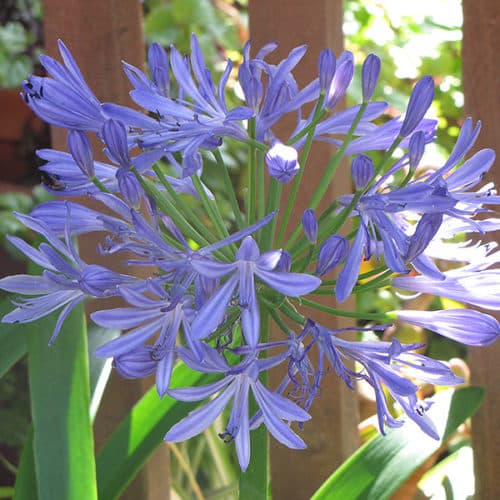Agapanthus Breeding: Tips for Expanding Your Plant Collection
Agapanthus Breeding: Tips for Expanding Your Plant Collection
Blog Article
Grasping the Art of Agapanthus Treatment: Necessary Steps for Healthy And Balanced Development and Vibrant Flowers
In the realm of horticulture, the cultivation of agapanthus stands as a gratifying undertaking for those that seek to nurture these stylish blooming plants. With their striking flowers and elegant vegetation, agapanthus has actually caught the focus of garden enthusiasts worldwide. Nevertheless, accomplishing optimum development and lively blooms calls for a nuanced method that encompasses numerous necessary actions. From picking the right variety to mastering pruning strategies, the journey in the direction of cultivating flourishing agapanthus plants is multifaceted and holds the vital to opening the full capacity of these organic gems.

Choosing the Right Agapanthus Selection

When picking the right Agapanthus range for your yard, take into consideration elements such as environment suitability, bloom color, and growth routine. Additionally, take into consideration the environment in your region to make certain the Agapanthus selection you choose can grow in your particular conditions. Recognizing the development routine of various Agapanthus varieties is vital for appropriate placement within your garden.
Ideal Growing Problems
Considering the ideal ecological needs is essential for successful Agapanthus farming. Agapanthus plants are delicate to cold temperatures and ought to be shielded from frost during wintertime months.
To make certain healthy growth and vivid blossoms, plant Agapanthus light bulbs at a depth of concerning 2-4 inches and room them 8-12 inches apart. Including organic matter, such as garden compost, to the dirt can boost drain and fertility, advertising robust root advancement. Mulching around the base of the plants assists maintain moisture and reduces weed growth. Routine watering is vital, specifically throughout the expanding season, to keep the soil regularly wet yet not soaked.
Watering and Feeding Tips
Maintaining proper moisture degrees and providing essential nutrients are essential elements in the treatment program for Agapanthus plants. When it comes to sprinkling Agapanthus, it is crucial to strike an equilibrium. These plants like regularly moist soil but are prone to root rot if overwatered.
Feeding Agapanthus is essential for advertising healthy and balanced growth and prolific flowers. Use a well balanced plant food, such as a 10-10-10 formula, in the very early spring as brand-new development emerges. Repeat this application every 6-8 weeks throughout the expanding period. Avoid too much fertilization, as it can bring about lush vegetation at the expenditure of blooms. Always comply with the manufacturer's guidelines for correct dilution and application techniques. By following these watering and feeding tips, you can ensure your Agapanthus plants flourish and create vivid, durable blossoms.
Trimming Methods for Agapanthus
Trimming Agapanthus plants at the proper times and with correct methods is critical for maintaining their health and advertising optimum growth and flowering. The optimal time to prune Agapanthus is in late winter months or early springtime before brand-new development arises.
Deadheading invested blossoms can likewise reroute the plant's energy right into generating even more flowers instead than establishing seeds. If you desire to gather seeds for breeding, leave some flowers to fully grown and completely dry on the plant.
Remember to utilize clean, sharp devices to make precise cuts and decrease the risk of presenting illness. Agapanthus. Regular pruning will assist maintain your Agapanthus my site looking neat and healthy while ensuring a plentiful display of lovely flowers
Handling Common Parasites and Diseases
After making certain appropriate pruning strategies for Agapanthus, it is necessary to address usual parasites and diseases that can influence the health and wellness and vitality of these plants. Agapanthus plants are normally hardy however can still drop sufferer to certain concerns. One common parasite that affects Agapanthus is the Agapanthus gall midget. This tiny, orange fly lays its eggs in the vegetation, resulting in altered growth and blossom buds that fail to open. To battle this insect, trim over here and destroy any type of affected plant components and think about making use of insecticidal soap.
In addition, Agapanthus plants can endure from origin rot if they are planted in badly draining dirt. By being vigilant and taking prompt action against pests and diseases, you can help your Agapanthus plants flourish and create dynamic flowers. Agapanthus.
:strip_icc()/purple-agapanthus-4637b426-ba6babc24ea34dce9361ec746f6ebc63.jpg)
Final Thought
Finally, grasping the art of agapanthus care entails selecting the right variety, offering ideal planting conditions, correct watering and fertilizing, proper pruning strategies, and dealing with usual pests and conditions. By adhering to these vital actions, you can make certain healthy and balanced development and vibrant blossoms for your agapanthus plants. Keep in mind to on a regular basis monitor and keep your plants to promote their overall wellness and durability.
To make sure healthy growth and vivid blooms, official site plant Agapanthus light bulbs at a deepness of regarding 2-4 inches and room them 8-12 inches apart. By following these watering and feeding suggestions, you can guarantee your Agapanthus plants thrive and generate vibrant, durable flowers.
One usual insect that impacts Agapanthus is the Agapanthus gall midge. Furthermore, Agapanthus plants can suffer from root rot if they are planted in improperly draining pipes dirt. By complying with these necessary steps, you can make certain healthy and balanced growth and vivid blooms for your agapanthus plants.
Report this page